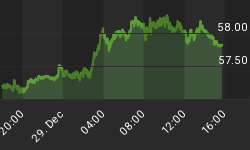Huh! What a week! As much as I am trying to get away from the theme, there is just no escaping the 'bail-out of the week' topic, especially as the fish being bailed out just keep getting bigger and bigger. And let me tell you, Bear Stearns is no small fish! The long end of the Treasury Bond market actually outperformed the shorter maturities as the market was buoyed by further safe-haven flows and a friendly CPI report. Interestingly, the rally is transpiring as there are some worrisome signals that a number of Treasury market players are not buying into this move. Open interest in the bond futures has fallen significantly during the past few weeks signaling that futures players are not enthused about bonds here. More of concern however is the lack of interest on the part of international buyers - namely Central Banks. Last week the Treasury had a 10 year bond auction. Overall interest was dismal, but foreign participation was worse. During the recent past, Central Banks have been large participants in Treasury Note auctions, sometimes purchasing as much as 50% or more of some issues. Their participation in the 10 year Note auction last Thursday was 5.8%. With the plunging US Dollar and negative real rates I don't think one can blame them for shying away from those purchases. This coming Tuesday the FOMC will announce a new and improved and lower Fed Funds rate. The question is not whether they lower rates but by how much. Guesstimates range from 50 to 75 to 100 basis points from the present 3%. It is really inconsequential how much they drop the rate as at this point the main issue that the financial markets must cope with is not the price of credit but the availability of it. Last week's emergency Term Securities Lending Facility provided a much needed boost on that front. I expect that program - presently at $200Billion - to grow significantly going forward. All the bail-outs, liquidity injections, government programs cost money, in this case, loads of money. The next question is: who will be left paying for the resulting enormous bill? Perhaps one might think that the government will. Two thoughts pop into mind. First, if the government will pay these bills, the taxpayer will eventually have to pay the government unless there will be a presently unfathomable default by the US Treasury. That begs the next question: how much longer should Treasury securities rated AAA. Based on recent experience with the likes of Ambac and MBIA, we should expect the rating agencies to stick with the AAA rating until the Treasury is on the brink of default.
NOTEWORTHY: The economic data was unequivocally lousy again last week. The Trade Deficit remains stubbornly high in spite of a melting US$. It is primarily propped up by the rising cost of energy imports. Meanwhile, as per the comments above, the Treasury Budget deficit is exploding. The Treasury reported a monthly deficit of $175.6 Billion in February, which is a new all-time record, eclipsing the old mark by close to a mind boggling 50%. Retail Sales declined 0.6% in February and I would suggest that is a deceptively "strong" figure. With rising food and energy prices consumers are paying more and getting less for their money. Retail Sales are also supported by foreign tourists on shopping binges as they take advantage of a magically disappearing dollar. Weekly Initial Jobless Claims remain stuck around 350k. CPI was unchanged both on the headline and core measures in February. Next week's headliners will include Industrial Production, Capacity Utilization, Housing Starts, PPI, Leading Indicators and the Philly Fed Survey.
INFLUENCES: Trader surveys remained optimistic on bonds during the past week. The present levels are creating a stiff headwind from a contrarian perspective. The Commitment of Traders reports indicate that Commercial traders are net long 38k 10 year Treasury Note futures equivalents, which remains neutral. Interesting to note that in spite of all the upheaval in financial markets, there has been no pulse, no bias whatsoever for months now on the COT front. Strange!. Seasonals are decidedly negative for the foreseeable future. The 10 year yield sliced through resistance at 3.5% this past week. I maintain that bonds represent no value here, so the recommendation remains to stay short or sell short if you have not done so already.
RATES: The US Long Bond future traded up 2½ points to close at 119-17, while the yield on the US 10-year note fell 11 basis points to 3.43%. The yield curve was slightly flatter last week. Long-short accounts can take advantage of the steepening trend by buying 2 year Treasuries against selling 10 year Treasuries on a risk weighted basis. This spread moved down 5 bps to 195 during the last week.
CORPORATES: Corporate bond spreads remain under pressure. During the past week the 30 year TransCanada Pipeline bond was 5 basis points wider to 190 ticks over long Canada bonds, while 10 year bank sub-debt moved out 30 basis points to 230 basis point premium to the government benchmark, its widest level yet. I recommended shorting the TransCanada Pipeline issue at Canadas +102 and the bank sub-debt issue at Canada bonds +58 basis points a while back. Certain segments of the credit markets represent good value now. However, with margin clerks very much in charge of the market, more near term pain is expected.
BOTTOM LINE: Bond yields declined last week. The fundamental backdrop is the worst of all worlds: slower growth - if any - with higher inflation. The trader sentiment and seasonals are negative, while the COT positions are neutral. My recommendation is to stay with the curve steepener, continue to shun the weaker corporate credits. The view on the long bond is negative.
















